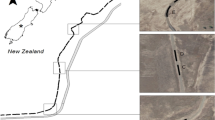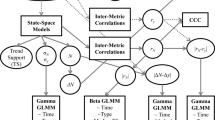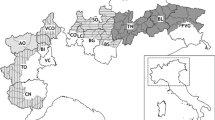Abstract
The use of hunting statistics for population monitoring has often been criticized because such data are affected by several sources of error. Still, for many harvested populations, hunting statistics are the only available data source and cautious use of such data may be valuable for management. Here we assessed to what extent long-term monitoring of Svalbard rock ptarmigan spring densities and hunting statistics (bag size and proportion of juveniles in the hunting bag) reflect similar population fluctuations. We found a decreasing trend in both bag size and proportion of juveniles in the bag, but no trend in ptarmigan spring densities. However, annual fluctuations of ptarmigan spring density and bag size were correlated. Together, these time series indicate that both population abundance (bag size) and recruitment (proportion of juveniles in the bag) are decreasing, but the reproductive component fraction (density of territorial males) is not yet compromised. This biological interpretation remains, however, uncertain due to lack of hunting effort data. Monitoring programs using hunting statistics should therefore critically discuss and evaluate what the hunting statistics reflect and fine-tune the hunter data collection to obtain maximum biological relevance. Still, our results illustrate that the combination of population estimates and hunting statistics can provide more nuanced information about the population status than the density estimates alone.



Similar content being viewed by others
References
Asmyhr L, Willebrand T, Hörnell-Willebrand M (2012) Successful adult willow grouse are exposed to increased harvest risk. J Wildlife Manag 76:940–943. doi:10.1002/Jwmg.340
Bech N, Beltran S, Boissier J, Allienne JF, Resseguier J, Novoa C (2012) Bird mortality related to collisions with ski-lift cables: do we estimate just the tip of the iceberg? Anim Biodivers Conserv 35:95–98
Bivand R, Rundel C, Pebesma E, Hufthammer KO (2014) rgeos: Interface to Geometry Engine - Open Source (GEOS), 0.3-8 edn.,
Born EW, Heilmann A, Holm LK, Laidre KL (2011) Polar bears in Northwest Greenland. An interview survey about the catch and the climate. Museum Tusculanum Press, University of Copenhagen, Denmark, Copengahen
Buckland ST, Anderson DR, Burnham KP, Laake JL, Borchers DL, Thomas L (2001) Introduction to distance sampling: Estimating abundance of biological populations. Oxford University Press
Buckland ST, Anderson DR, Burnham KP, Laake JL, Thomas L (2004) Advanced distance sampling. Estimating abundance of biological populations. Oxford University Press
Calenge C (2006) The package adehabitat for the R software: tool for the analysis of space and habitat use by animals. Ecol Model 197:1035
Carroll CJ, Merizon RA (2014) Status of grouse, ptarmigan and hare in Alaska, 2014. Alaska Department of Fish and Game. Division of Wildlife Conservation, Palmer, Alaska
Cattadori IM, Haydon DT, Thirgood SJ, Hudson PJ (2003) Are indirect measures of abundance a useful index of population density? The case of red grouse harvesting. Oikos 100:439–446. doi:10.1034/j.1600-0706.2003.12072.x
Elvebakk A (1994) A survey of plant associations and alliances from Svalbard. J Veg Sci 5:791–802. doi:10.2307/3236194
Fletcher K, Aebischer NJ, Baines D, Foster R, Hoodless AN (2010) Changes in breeding success and abundance of ground-nesting moorland birds in relation to the experimental deployment of legal predator control. J Appl Ecol 47:263–272. doi:10.1111/j.1365-2664.2010.01793.x
Fuglei E, Pedersen ÅØ (2011) Svalbardrypenes trekkruter til vinterområdene. Rapport til Svalbards Miljøfond (in Norwegian)
Hannon SJ (1983) Spacing and Breeding Density of Willow Ptarmigan in Response to an Experimental Alteration of Sex-Ratio. J Anim Ecol 52:807–820. doi:10.2307/4455
Hansen BB et al (2013) Climate events synchronize the dynamics of a resident vertebrate community in the High Arctic. Science 339:313–315. doi:10.1126/science.1226766
Hansen BB et al (2014) Warmer and wetter winters: characteristics and implications of an extreme weather event in the High Arctic. Environ Res Lett 9:114021
Hörnell-Willebrand M, Marcstrom V, Brittas R, Willebrand T (2006) Temporal and spatial correlation in chick production of willow grouse Lagopus lagopus in Sweden and Norway. Wildlife Biol 12:347–355. doi:10.2981/0909-6396(2006)12[347:Tascic]2.0.Co;2
Imperio S, Bionda R, Viterbi R, Provenzale A (2013) Climate change and human disturbance can lead to local extinction of alpine rock ptarmigan: new insight from the western Italian Alps. PLoS ONE 8:e81598. doi:10.1371/journal.pone.0081598
Imperio S, Ferrante M, Grignetti A, Santini G, Focardi S (2010) Investigating population dynamics in ungulates: do hunting statistics make up a good index of population abundance? Wildlife Biol 16:205–214. doi:10.2981/08-051
Ims RA, Jepsen JU, Stien A, Yoccoz NG (2013) Science plan for COAT: Climate Ecological Observatory for Arctic Tundra. Fram Centre, Norway
Johansen BE, Karlsen SR, Tommervik H (2012) Vegetation mapping of Svalbard utilising Landsat TM/ETM plus data. Polar Res 48:47–63. doi:10.1017/s0032247411000647
Kausrud KL et al (2008) Linking climate change to lemming cycles. Nature 456:93–97
Keane A, Jones JPG, Milner-Gulland EJ (2011) Encounter data in resource management and ecology: pitfalls and possibilities. J Appl Ecol 48:1164–1173. doi:10.1111/j.1365-2664.2011.02034.x
Lande US, Herfindal I, Finne MH, Kastdalen L (2010) Use of hunters in wildlife surveys: does hunter and forest grouse habitat selection coincide? Eur J Wildlife Res 56:107–115. doi:10.1007/s10344-009-0291-2
Lee AM et al (2015) An integrated population model for a long-lived ungulate: more efficient data use with Bayesian methods. Oikos 124:806–816. doi:10.1111/oik.01924
Lehikoinen A, Green M, Husby M, Kalas JA, Lindström A (2014) Common montane birds are declining in northern Europe. J Avian Biol 45:3–14. doi:10.1111/j.1600-048X.2013.00177.x
Løvenskiold HL (1964) Avifauna Svalbardensis vol 129. Oslo, Norway
Marques TA, Thomas L, Fancy SG, Buckland ST (2007) Improving estimates of bird density using multiple-covariate distance sampling. Auk 124:1229–1243
Marty E, Mossoll-Torres M (2012) Point-count method for estimating rock ptarmigan spring density in the Pyrenean chain. Eur J Wildlife Res 58:357–363. doi:10.1007/s10344-011-0541-y
Matsuoka SM, Mahon CL, Handel CM, Solymos P, Bayne EM, Fontaine PC, Ralph CJ (2014) Reviving common standards in point-count surveys for broad inference across studies. Condor 116:599–608. doi:10.1650/Condor-14-108.1
Ministry of Climate and Environment (2015) Regulations relating to harvesting of the fauna on Svalbard. https://www.regjeringen.no/en/dokumenter/harvesting-fauna-svalbard/id512066/. Accessed 24.02.2015
Nielsen OK (1999) Gyrfalcon predation on ptarmigan: numerical and functional responses. J Anim Ecol 68:1034–1050. doi:10.1046/j.1365-2656.1999.00351.x
Overrein Ø (2014) Status for høstbare viltarter på Svalbard – Helhetlig strategi for kunnskapsinnhenting (in Norwegian). Norwegian Polar Institute, Norway
Parker H, Ottesen H, Knudsen E (1985) Age determination in Svalbard ptarmigan Lagopus mutus hyperboreus. Polar Res 3:125–126
Pedersen HC, Steen H, Kastdalen L, Broseth H, Ims RA, Svendsen W, Yoccoz NG (2004) Weak compensation of harvest despite strong density-dependent growth in willow ptarmigan. P R Soc B 271:381–385. doi:10.1098/rspb.2003.2599
Pedersen ÅØ, Bårdsen BJ, Yoccoz NG, Lecomte N, Fuglei E (2012) Monitoring Svalbard rock ptarmigan: distance sampling and occupancy modeling. J Wildlife Manag 76:308–316. doi:10.1002/jwmg.276
Pedersen ÅØ, Jepsen JU, Yoccoz NG, Fuglei E (2007) Ecological correlates of the distribution of territorial Svalbard rock ptarmigan (Lagopus muta hyperborea). Can J Zool 85:122–132
Pedersen ÅØ, Overrein Ø, Unander S, Fuglei E (2005) Svalbard Rock Ptarmigan (Lagopus mutus hyperboreus) – a status report. vol 125. Tromsø, Norway
Pedersen ÅØ, Soininen EM, Unander S, Willebrand MH, Fuglei E (2014) Experimental harvest reveals the importance of territoriality in limiting the breeding population of Svalbard rock ptarmigan. Eur J Wildlife Res 60:201–212. doi:10.1007/s10344-013-0766-z
Pettorelli N, Cote SD, Gingras A, Potvin F, Huot J (2007) Aerial surveys vs hunting statistics to monitor deer density: the example of Anticosti Island, Quebec, Canada. Wildlife Biol 13:321–327. doi:10.2981/0909-6396(2007)13[321:Asvhst]2.0.Co;2
Potapov R, Potapov E (2011) Willow and Rock Ptarmigan monitoring in Russia: An historic overview. In: Watson RT, Cade TJ, Fuller M, Hunt G, Potapov E (eds) Gyrfalcons and Ptarmigan in a Changing World, Volume II. The Peregrine Fund, Boise, Idaho, USA, pp 213–228
R Core Team (2014) R: a language and environment for statistical computing. R Foundation for Statistical Computing, Vienna, Austria
Ranta E, Lindström J, Lindén H, Helle P (2008) How reliable are harvesting data for analyses of spatio-temporal population dynamics? Oikos 117: 1461-1468
Revermann R, Schmid H, Zbinden N, Spaar R, Schröder B (2012) Habitat at the mountain tops: how long can Rock Ptarmigan (Lagopus muta helvetica) survive rapid climate change in the Swiss Alps? A multi-scale approach. J Ornithol 153:891–905. doi:10.1007/s10336-012-0819-1
Rist J, Rowcliffe M, Cowlishaw G, Milner-Gulland EJ (2008) Evaluating measures of hunting effort in a bushmeat system. Biol Conserv 141:2086–2099. doi:10.1016/j.biocon.2008.06.005
Rosenstock SS, Anderson DR, Giesen KM, Leukering T, Carter MF (2002) Landbird counting techniques: current practices and an alternative. Auk 119:46–53. doi:10.1642/0004-8038(2002)119[0046:Lctcpa]2.0.Co;2
Sandercock BK, Martin K, Hannon SJ (2005) Demographic consequences of age-structure in extreme environments: population models for arctic and alpine ptarmigan. Oecologia 146:13–24. doi:10.1007/s00442-005-0174-5
Sandercock BK, Nilsen EB, Brøseth H, Pedersen HC (2011) Is hunting mortality additive or compensatory to natural mortality? Effects of experimental harvest on the survival and cause-specific mortality of willow ptarmigan. J Anim Ecol 80:244–258. doi:10.1111/j.1365-2656.2010.01769.x
Solberg EJ, Loison A, Saether BE, Strand O (2000) Age-specific harvest mortality in a Norwegian moose Alces alces population. Wildlife Biol 6:41–52
Steen JB, Unander S (1985) Breeding biology of the Svalbard rock ptarmigan Lagopus mutus hyperboreus. Ornis Scand 16:191–197. doi:10.2307/3676630
Storch I (2007a) Conservation status of grouse worldwide: an update. Wildlife Biol 13:5–12. doi:10.2981/0909-6396(2007)13[5:Csogwa]2.0.Co;2
Storch I (2007b) Grouse: Status Survey and Conservation Action Plan 2006–2010. Gland, Switzerland: IUCN and Fordingbridge, UK: World Pheasant Association
Sutherland WJ (2001) Sustainable exploitation: a review of principles and methods. Wildlife Biol 7:131–140
Thomas L et al (2010) Distance software: design and analysis of distance sampling surveys for estimating population size. J Appl Ecol 47:5–14. doi:10.1111/j.1365-2664.2009.01737.x
Thompson WL, White GC, Gowan C (1998) Monitoring vertebrate populations. Academic Press
Unander S, Steen JB (1985) Behavior and social structure in Svalbard rock ptarmigan Lagopus mutus hyperboreus. Ornis Scand 16:198–204
Walker DA et al (2005) The circumpolar Arctic vegetation map. J Veg Sci 16:267–282
Wang GM, Hobbs NT, Giesen KM, Galbraith H, Ojima DS, Braun CE (2002) Relationships between climate and population dynamics of white-tailed ptarmigan Lagopus leucurus in Rocky Mountain National Park, Colorado, USA. Clim Res 23:81–87. doi:10.3354/Cr023081
Wann GT, Aldridge CL, Braun CE (2014) Estimates of annual survival, growth, and recruitment of a white-tailed ptarmigan population in Colorado over 43 years. Popul Ecol 56:555–567. doi:10.1007/s10144-014-0452-3
Warren P, Baines D (2011) Evaluation of the distance sampling technique to survey red grouse Lagopus lagopus scoticus on moors in northern England. Wildlife Biol 17:135–142. doi:10.2981/10-085
Watson A, Moss R, Rothery P (2000) Weather and synchrony in 10-year population cycles of rock ptarmigan and red grouse in Scotland. Ecology 81:2126–2136. doi:10.1890/0012-9658(2000)081[2126:Wasiyp]2.0.Co;2
Weeden RB, Theberge JB (1972) The dynamics of a fluctuating population of rock ptarmigan in Alaska. Proceedings Int Ornithologal Congress 15:90–106
Willebrand T, Hörnell-Willebrand M, Asmyhr L (2011) Willow grouse bag size is more sensitive to variation in hunter effort than to variation in willow grouse density. Oikos 120:1667–1673. doi:10.1111/j.1600-0706.2011.19204.x
Acknowledgments
We thank all field assistants who have participated in the annual monitoring of the Svalbard rock ptarmigans, especially Marie Lier, Heli Routti, Øystein Overrein, and Nina A. Seifert; the Governor of Svalbard for collecting the hunting statistics, especially the Nature Management advisors Bjarte Benberg and Egil Movik; Audun Igesund and Oddveig Øien Ørvoll for graphical assistance; Gunn-Sissel Jaklin for reviewing the English language; and Arnaud Tarroux for guidance to GIS in R. Rolf Ims, Arnaud Tarroux, Øystein Overrein, and three anonymous reviewers gave helpful comments on the manuscript. Personnel costs were provided by the Fram Centre COAT initiative and the Norwegian Polar Institute. Funding for field work was provided by grants from the Amundsen Center of Arctic Research (The Arctic University of Norway), the Governor of Svalbard, the Norwegian Polar Institute, and the Svalbard Environmental Protection Fund.
Author information
Authors and Affiliations
Corresponding author
Ethics declarations
Ethical statement
The hunting of Svalbard rock ptarmigans comply with the regulations in The Svalbard Environmental Protection Act. This article does not contain any studies where human participants or animals were manipulated by any of the authors.
Conflict of interest
The authors declare that they have no conflict of interest.
Rights and permissions
About this article
Cite this article
Soininen, E.M., Fuglei, E. & Pedersen, Å.Ø. Complementary use of density estimates and hunting statistics: different sides of the same story?. Eur J Wildl Res 62, 151–160 (2016). https://doi.org/10.1007/s10344-016-0987-z
Received:
Revised:
Accepted:
Published:
Issue Date:
DOI: https://doi.org/10.1007/s10344-016-0987-z




